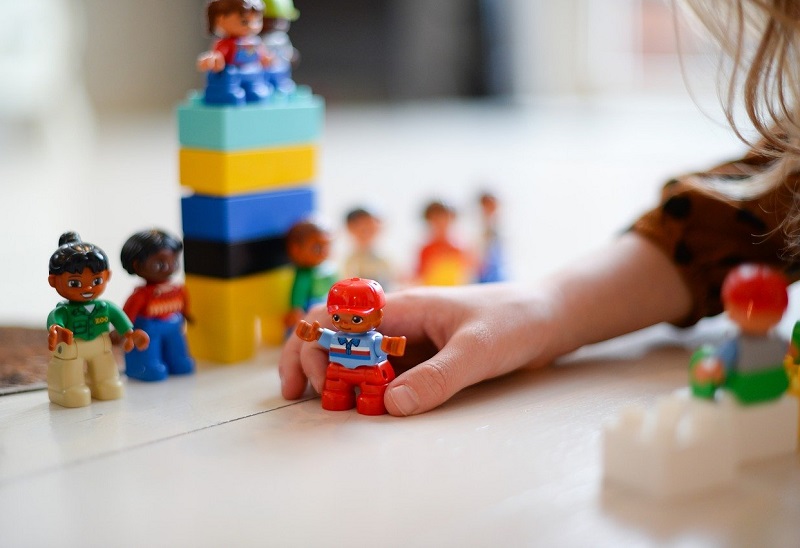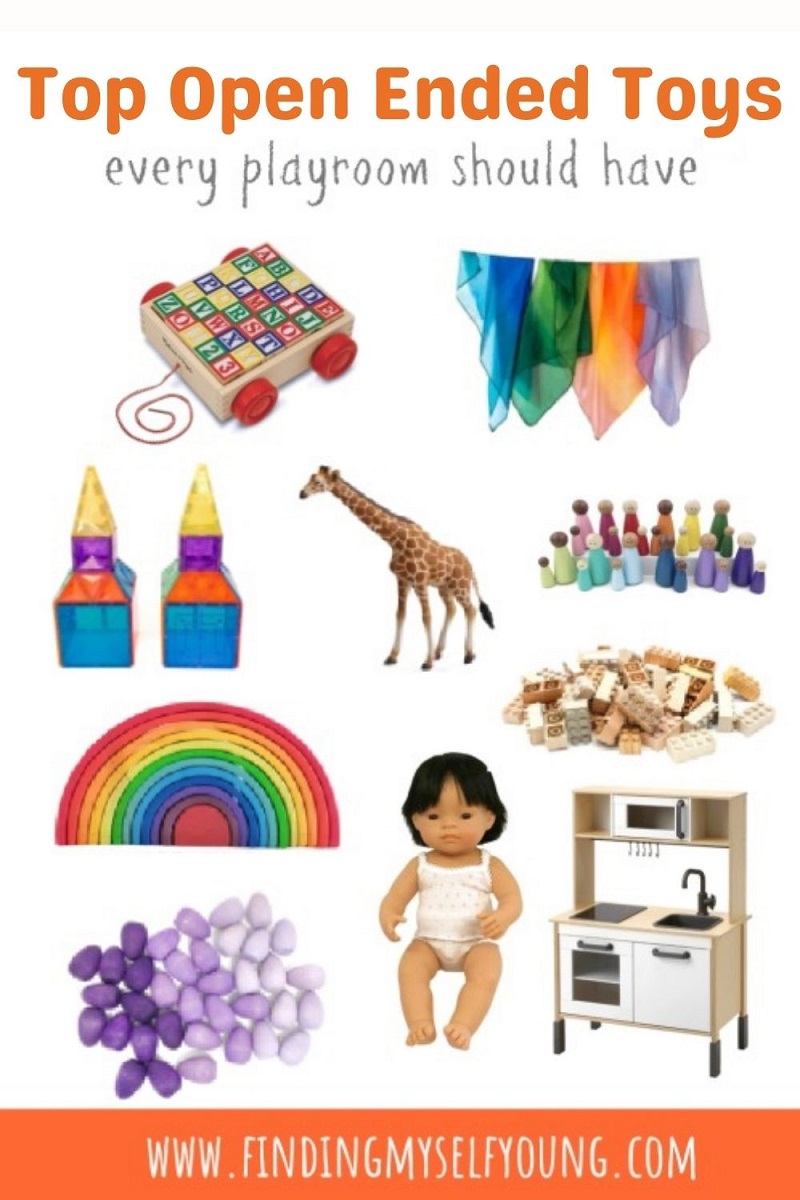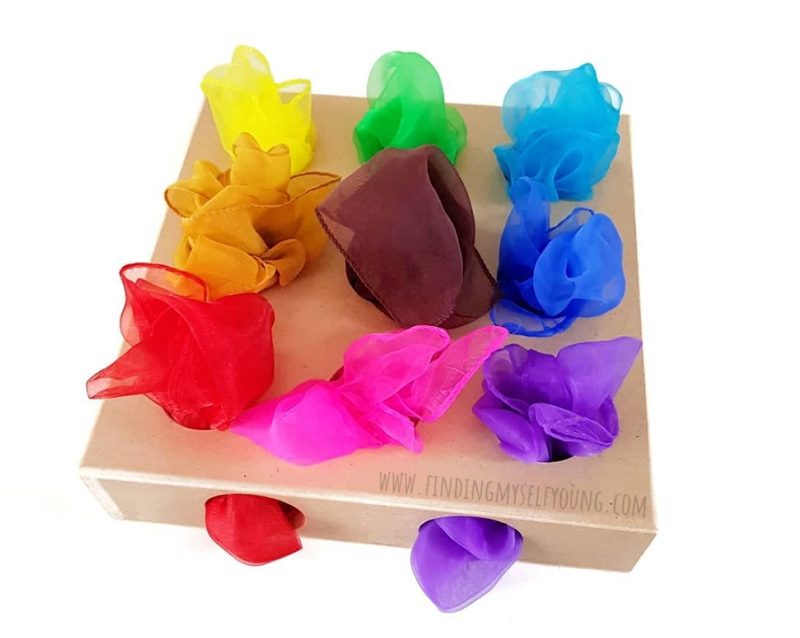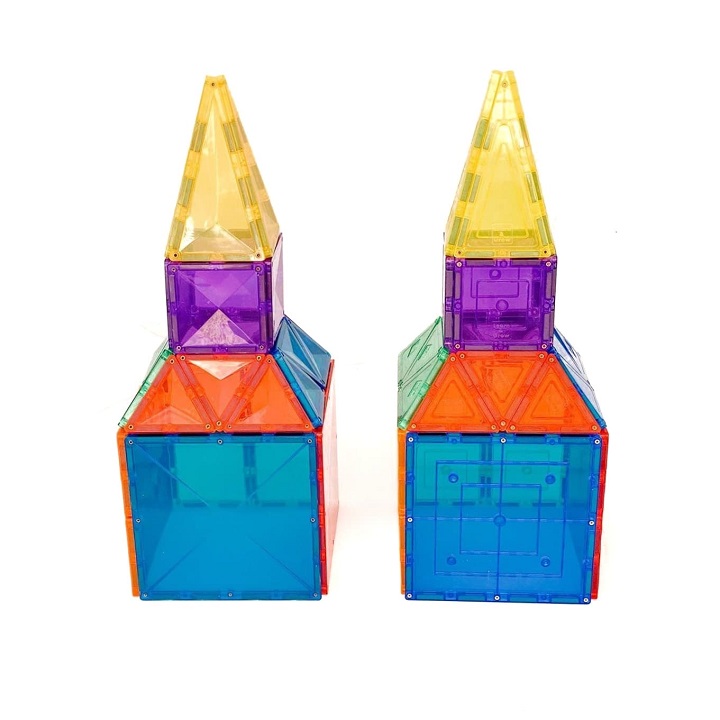Wanting to add more open ended toys to your playroom, daycare or classroom, but don't know where to start? I get it, there's so many options it can be a bit overwhelming at first. To help you get started, I've put together a list of the top 12 open ended toys every playroom should have. They're also great for kindy and prep classrooms as well. No matter what age your kids are, these toys will grow with them and can be used in many different ways as they get older and develop more skills.
WHAT IS AN OPEN ENDED TOY?
Open ended toys can be played with in multiple ways, rather than having one particular outcome. Play with these toys is directed by the child themselves and driven by their imagination, rather than a list of instructions or directives. I think of open ended toys like process art, because the focus is moreso on the process of playing and the imagination and creativity that is sparked, rather than playing in the correct way or creating something perfect.
There's been a lot of debate about whether open ended toys are classed as passive toys because the toys themselves don't do anything {i.e. there's no flashing lights or songs activated with buttons} or whether they're active toys because children are actively playing with them instead of passively watching them flash and beep.
Regardless of how you define them, the quintessential difference with open ended toys is that the play is 100% initiated and dependent on child led interaction with the toy. Also each and every time they play with open ended toys, even if it's the same toy, the play will always be different.
Open ended toys are the best investment when it comes to toys because of their many varied and never ending play opportunities. They naturally grow with your child. As your child gains more developmental skills and engages in more imaginary play, the way they play with open ended toys will evolve. There's no need to replace open ended toys as children get older as they won't outgrow them or get bored with them doing the same thing over and over.
WOODEN BLOCKS
One of the first toys most children usually receive as infants are building blocks. Basic blocks are great for encouraging young children to grasp, stack and knock them over, introducing them to balance and cause and effect. As children get older they'll be able to build bigger towers and structures, count blocks and colour sort them.
Even though blocks seem like quite a generic toy, there are many different sets and brands available. When I was younger square alphabet blocks were the most popular alongside basic wood blocks.
These days there's so many different types of block sets available including huge block sets like the Grimms large stepped pyramid and basic building set. Bauspiel colour street gem blocks and big castle block sets are also popular alternatives. There's also brands such as Just Blocks, and The Wooden Toy Co creating a resurgence in popularity for traditional basic building blocks.
PLAYSILKS
Playsilks are often overlooked when it comes to toys because they aren't thought of as a traditional toy, however they're one of the most versatile play resources available. Playsilks can be used to encourage eye tracking in babies, develop fine motor skills, learn colours and provide endless opportunities for role playing and imaginary play. They also work really well for children of all ages from infants through to tweens.
For young babies they can be used for playing peek-a-boo, or hung off a baby play gym just out of reach to encourage eye tracking and grasping. When my daughter was one I scrunched up some coloured silks into a cat toy {see below} so she could grab them and pull them out, she then posted them back into the holes too.
Playsilks are also great as capes, butterfly wings, flags or for building forts. Our favourite way to play with them is using them as small world bases - green silks for grass, blue silks for water and orange, red or yellow silks for desert scenes.
For years Sarah's Silks have widely been considered the leading brand when it comes to play silks, they're available in mini silks, individual silk colours, giant silk playscapes and The Creative Toy Shop has a Sarah's Silks subscription box with different silks sent each month.
Vintage Silk Creations on Etsy also make beautiful play silks from vintage Indian and Habotai silks. If you're looking for a more affordable option op shops are a great place to find thrifted silk scarves or Amazon {AU} have bright juggling scarves or polyester play silks in bulk colour packs.
MAGNETIC TILES
Magnetic tiles are hands down probably the best toy we own. My girls play with ours every single day either building towers or using them for imaginary play with other toys. Kids can stack them, count them, colour sort them, use them on multiple surfaces and get super creative with them {see my post of over 50 ways to play with magnetic tiles for more play ideas}.
Magnetic tiles are a stem toy, so children are learning about science, technology, engineering and mathematical concepts naturally while playing with them. Magnetic tiles are great for fine and gross motor development, hand/eye co-ordination, spatial awareness, understanding balance, problem solving and hypothesising among many other skills. By playing with the tiles and building children are naturally exploring cause and effect and problem solving to reach their desired outcome.
Magnetic tiles are great for children of all ages from toddlers through to older school children, their ability to manipulate and build with the tiles will increase as they get older. There are many magnetic tile brands available with the most popular in Australia being Connetix, Learn & Grow {you can read a detailed review of these brands here}, Magblox {read a full review of Magblox here} and Magbrix. There's also Picasso Tiles, Magna-Tiles and Playmags which are popular worldwide.
ANIMAL FIGURINES
Animal figurines are an amazing open ended toy as they can be used in so many different types of play. When children are younger they're great to use alongside animal flashcards or books to match the animals and learn the animal names. They can also be used in simple play ideas for toddlers like an animal tape resist rescue, playdough stamping footprints, or categorising the animals by habitats {e.g. land or sea}. As children get older animal figurines are great for retelling stories with bookish play and they're perfect for small world play.
We prefer plastic animals in our house and have a mixture of CollectA and Schleich brands {here's our favourite play ideas using plastic dinosaurs}. We chose plastic because they can then be used in the bath tub, water play or messy sensory play without fear of them getting damaged, they also don't have any holes so don't go mouldy in water.
There are however lots of wooden animal figurine brands that are quite popular like Ostheimer, Holztiger, Iz Vetvey and Tender Leaf Toys. There's also a number of handmade stores on Etsy that make gorgeous wooden animal figurines.
PEG PEOPLE
Peg dolls are a great way to introduce young children to role playing as they can easily grasp a peg doll in their hand and carry it around from one spot to the other. Peg people provide visual and tactile sensory input and can be used in imaginary play and story telling.
They're particularly popular in Waldorf education where the emphasis is on toys made from natural materials that inspire creative play. Because the peg dolls themselves don't do anything, the onus is on the child to manipulate them and create a story line to initiate play.
Many peg dolls, like the ones pictured above from My Big World Playscapes, come in plain colours with limited facial details leaving their gender, occupation and expression open to interpretation. Are they a mum, dad, sister, brother? Doctor, teacher, farmer, zoo keeper or astronaut? Happy, sad, tired, excited etc... It's all up to the child.
There are many different versions of peg people around, for example Grapat have nins, magos, tomtens, palos and brots. There's also Grimm's friends, Papoose gnomes and many hand painted peg people on Etsy. There's also many blank peg dolls available on Etsy that you can paint yourself.
WOODEN RAINBOW
A lot of people think wooden stacking rainbows are just pretty pieces of room decor to have sitting on the shelf, however they're actually one of the most open ended toys available, you just have to think outside the box. Wooden rainbows can be played with flat, vertically and turned into three dimensional objects. They can be a tunnel, house, bridge, mountain, wall, ball run, stacking toy and even numerous animals. Yes rainbows can be animals, check out my post of 50+ ways to play with a Grimms rainbow for even more ideas.
By engaging in play and exploring the rainbow and its possibilities children are naturally learning and developing a wide range of skills. While they're playing with a rainbow they're exploring maths and engineering concepts, hypothesising and problem solving to place the pieces in just the right way. They're learning about balance, counter balancing, weight, height, spatial awareness and sequencing amongst other skills.
When people think of wooden rainbows they naturally think of the traditional Grimms rainbow which is arguably the most popular and recognisable wooden rainbow in the toy market. However, with limited restocks each year they can sometimes be hard to find, but luckily there are many other brands of rainbows available in all different colour ways. Ocamora and Raduga Grez have their own rainbows in various colours.
Lots of Etsy stores including Bumbu Toys, My Happy Helpers, Happy Tree Store, Noelle Handmade, Tree Sounds and SABO Concept make wooden stacking rainbows in bright, pastel, natural and earthy tones. I also have a printable rainbow play ideas PDF available on Etsy which has 40 different rainbow play images that can be used as a look book or flashcards as inspiration for building with any wooden rainbow.
DOLLS
Playing with dolls is a great way for children, regardless of their gender, to practice social and emotional skills by modelling real life experiences. Role playing with baby dolls by feeding, comforting, changing and rocking them to sleep teaches children to nurture, be empathetic and learn responsibility. During their imaginary play they also naturally develop their language skills as they talk both to the dolls and for them. Dolls can also be used to learn body parts, new routines e.g. preparing for school, learning to help take care of a new sibling and for fine motor practice like we did with this bandaid matching activity.
There are many different types of dolls including hard bodied, soft bodied, plush and anatomically correct available in both sexes. We have a mixture of different dolls in our house, but Miniland dolls and Barbie dolls are her favourite. I personally love the Miniland dolls the most as they're anatomically correct and are available in multiple ethnicity's as well as down syndrome dolls, so they're a great way to introduce children to diversity. Other popular doll brands include Ollie Ella Dinkum Dolls, Paola Reina, Bonikka, Cabbage Patch Kids, Baby Born, Baby Alive and Waldorf style Evi dolls. There's also a great range of affordable handmade dolls clothes and miniland dolls clothes available on Etsy.
BUILDING BRICKS
Building bricks extend on block play by clicking into place rather than just stacking on top of each other. Playing with building bricks has many developmental benefits for children, with the most obvious one being building fine motor skills. Children need to use their pincer grip to grasp individual blocks and then work on hand strengthening while clicking blocks into place or pulling them apart. They're also using cognitive skills hypothesising and problem solving as they create with the blocks. Building bricks can also be used to teach mathematical skills like counting, one to one correspondence, addition, subtraction and fractions. Coloured bricks can also be used to teach colours.
The most popular building bricks are of course Lego, however there's also Mokulock which is a brand of wooden building bricks made in Japan. Read my full review of Mokulock here. Small building bricks do pose a choking risk to young children and are usually recommended for 5+, however there are larger brick options for toddlers like Duplo, Mega Bloks and Tsumiki {larger sized Mokulock blocks}. As children get older they'll be able to handle the smaller building bricks and make more complex structures.
LOOSE PARTS
Loose parts play is probably the most open ended play possible as children can use loose parts, which don't necessarily have to be toys, to create anything they want. Loose parts play involves lots of exploration and investigation as children manipulate the loose parts to create. It also aids fine motor development, risk taking and problem solving as well as helping to foster independent play.
When children are young loose parts play can be as simple as a heuristic play tray using household items. My daughters favourite way to play with loose parts is using items like toothpicks, paddle-pop sticks, googly eyes, pom poms and pipe cleaners with playdough to create aliens or monsters. Loose parts are also great for mindfulness activities like creating mandalas or transient art. Please remember that small loose parts can pose a choking risk to mouthing children.
 |
| Image | Grapat Instagram |
The most popular toy brand for loose parts is no doubt Grapat who have a large range of wooden loose parts including mandala pieces. Totli also have leaves, rings, cups and coins {use the code FMY10 to save 10%}. Loose parts don't have to be toys though, nature offers lots of loose parts including leaves, sticks, rocks, seed pods, petals and pine cones. Craft items like buttons, googly eyes, pom poms and beads are also popular loose parts. Op shops are also a treasure trove for thrifted loose parts like necklace beads and napkin rings
PLAY KITCHEN
To me having a play kitchen seems like a natural rite of passage for most kids. I mean how many times did you pretend to cook play food when you were a child? I never had a play kitchen or proper play food as a kid {we used coloured pegs as pretend food}, so of course when I had my own kids a play kitchen and play food were the main toys I wanted to get {as much for me as them if I'm honest}. We got our Ikea play kitchen when our first daughter turned 2 and the girls still use it every day 5yrs later. In fact our playroom is now full of Ikea items, see our favourites here.
Now you may be thinking how is a play kitchen open ended, it's just a kitchen... but is it really just a kitchen? Our play kitchen has been a kitchen, a grocery store, a bakery and a supermarket. With a little imagination, and a few props, a play kitchen can be transformed into many different things.
The Ikea Duktig play kitchen, thanks to it's neutral design and open backing board, transforms into different shops or a market stand really easily. Simply turn it around and add some homemade signs or printables like the the dramatic play sets from Little Lifelong Learners to change your play kitchen into a shop. If you read my post about how to hack the Ikea play kitchen, you'll also find heaps of stores that sell amazing shop front decals made to fit the Ducktig perfectly.
If the Ikea kitchen doesn't suit your taste or space, there are many other play kitchens available in all different designs. Some of the most popular ones are Kidkraft, Hape and Drewart.
PLAY COUCH
A play couch is one of the best gross motor resources available for parents to use at home. Play couches are a more affordable and aesthetic alternative to traditional foam play equipment that is often used for occupational and physiotherapy.
A play couch is more than a piece of furniture, it can be anything you want it to be - a shop, rocket, castle, fort, stage, bed, reading nook and more. Play couches promote lots of big movements like jumping, sliding and climbing whilst also encouraging imaginary play. Our favourite play couch brand is Whatsie and you can use the discount code FMY to save on any Whatsie products. Read a full review of our Whatsie play couch here.
WOBBEL BOARD
If your kids are sensory seekers and love gross motor fun, a Wobbel board is also a great addition. The Wobbel encourages children to be active inside and provides lots of opportunities for gross motor fun, imaginary play and emotional regulation. A Wobbel board is also a great tool to improve core strength, balance, spatial awareness and cognitive skills in children and adults. Here's 19 different ways we use our Wobbel board for play and exercise.
MORE OPEN ENDED TOY IDEAS
Disclosure - This post contains some affiliate links for your convenience which means I may earn a small commission, at no cost to you, should you make a purchase.






















